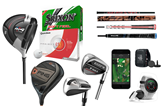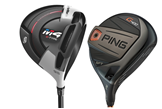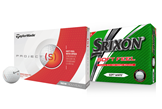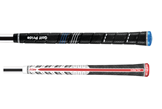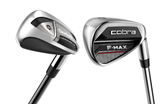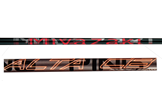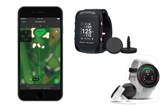The Gear To Help You Fix Your Slice
Published: Last updated:
The gear that will help you fix your slice: From “draw” drivers to softer balls, you can buy your way to straighter shots
PART 1. The Drills To Help You Fix Your Slice
PART 2. Fault Fix: The Cost Of A Slice In Shots, Data & In Your Head
1. DRAW WOODS
Draw woods are nothing new, but draw drivers in particular have made a sizeable comeback, and now all the leading brands make one. How does a draw driver differ from a regular model? Usually there’s more weight located towards the heel, some have offset hosels and some will have a subtly closed face angle, which points left of the target.
How they work
It’s common for draw woods to come with higher lofts, and that’s because slicing golfers often have slower swings. But more loft also means less side spin, which increases accuracy. Heel weighting helps position the centre of gravity more in-line with the typical impact position of a slicer, and an offset hosel gives a fraction more time to square the clubface at impact. The idea of a closed clubface (points left of the target) is that a slicer’s swing is more likely to deliver the clubface square to the target line.
Our Favourite Draw Woods
Ping G400 SFT driver and fairway £389 / £240
TaylorMade M4 D-Type £369
Callaway Rogue Draw £469
Cobra F-Max Superlite driver, fairway and hybrid £249 / £179 / £159

2. IRONS
There aren’t many brands who shout about draw-biased irons, but Cobra’s new F-MAX Superlite have “Draw” stamped on the head. More brands probably don’t do it because if they did, they’d put off half the potential customers who’d be interested in a set. More golfers need help squaring the clubface and most don’t like to admit it. The truth of the matter is that a lot of game improvement models probably have a degree of draw bias built in anyway.
How they work
Let’s take Cobra’s new F-MAX as an example. Generally, there’s more mass positioned towards the heel than the toe. It means the weight naturally wants to rotate around the shaft and slam the clubface square or closed to the target line at impact. Extra offset also helps square the face, as it gives a little more time before impact occurs. Hybrid-style irons can also help, because their wider heads have a centre of gravity more towards the heel, so naturally have a more left sided tendency.
Our Favourite Draw Based Irons
Cobra F-Max Superlite: From £499
Cleveland Launcher HB: £570 (s) £648 (g)

3. THE BALL
Callaway started a golf ball revolution when they introduced the original Chrome Soft a few years ago. It brought low compression, soft feeling golf balls centre stage, with tour usage and a very competitive price tag compared to other tour balls. Every golf ball brand now has a soft/low compression model and it’s how they spin less which makes them straighter.
How they work
Golf ball engineers didn’t really set out to make more accurate balls; more accuracy is actually a by-product of creating lower-spinning balls to go further. Callaway say their pros spotted how Chrome Soft was actually too straight. It meant they couldn’t shape shots, especially with irons into tight pin positions. So they made a firmer, higher spinning Chrome Soft X.
How they work is down to some clever physics and how the different layers of a ball compress and bounce back in tandem, along with the velocity that’s generated. All you need to know is less sidespin means more accuracy. Just don’t think all low compression balls are low spin – they’re not.
Our Favourite Low Spin Ball is…
Callaway Chrome Soft: £38
Wilson Staff DX2 Soft: £19.99
Srixon Soft Feel: £24
TaylorMade Project (s): £24.99

4. SHAFTS
Like most things in golf there’s no hard and fast rules when it comes to shafts helping a slice. Common thinking used to be that shafts which were too sti led to weak, low shots to the right, which obviously isn’t going to help beat a slice. But others will say ‘I don’t slice sti shafts’. If that’s the case, carry on using them. However, technology’s come on leaps and bounds around shafts so if you’re looking at incremental gains across every slice- busting denominator there’s never been a better time to look again at shafts to help.
How it works
You’ve only got to look at draw biased drivers and ironstoseethepicture. Most come as standard with lighter shafts and some with lighter overall mass and swing weights. Lighter shafts (no matter whether they’re graphite or steel) are usually designed to increase club speed (which can help golfers square the club face) and launch shots higher. Counter- balanced models usually mean heavier head weights which can give golfers more time to get back to square at impact and improve speed and energy transfer.
Our Favourite Lightweight Shafts …
Ping Alta CB 55 or Distanza 40g: On Ping drivers
Aldila Synergy 50: On Callaway drivers
Cobra Superlite 45: On Cobra F-Max drivers
KBS MAX: On Callaway Rogue X and TaylorMade M4 irons

5. GRIPS
Jumbo-sized grips used to be really popular with some golfers, mainly because they felt really comfortable in the hands. Older golfers, especially those who su er with tight joints or arthritis in the ngers, were big fans once upon a time. That was until it got out that oversized grips can inhibit the hands working through impact, which again leads to an open club face and slapped shots to the right side of the course.
How they work
We’re not saying use the thinnest grip you can get your hands on. If OS grips are the only way you can play the game with arthritis, stick with them. But if you’ve bought oversized grips over the last few years just because they felt good, it could be time to have a look at more standard sized models. Many experts will say thinner grips allow golfers to use the hands more during impact, which helps – you’ve guessed it–to square the clubface and keep a slice in check.
Our Favourite Grips
Golf Pride Tour Velvet 360: From £6
Golf Pride MMC ALIGN: From £16
SuperStroke S-Tech: £9
Lamkin UTx Cord: £13

6.TECH CAN HELP, TOO…
The shot tracking specialists at Shot Scope say golfers would stand more chance hitting greens with approaches if they aimed at the back left corner of the green and took a club to go 11 yards further than their yardage suggests. Their reasoning is two-fold. One, most golfers think they hit the ball further than they actually do. And two, club golfers have a horrible tendency of slapping shots weakly away to the right side of the green.
How it works
You pop shot trackers in the end of each grip in your set and they talk to an app (or you wear a watch like the Shot Scope which gathers the information). After every round you can see where each shot has ended up. By looking for trends and patterns, you can see how badly a slice is affecting your scores.
Our Favourite Shot Trackers
Shot Scope V2: £225
Arccos 360: £249
Game Golf Pro: £299.99
Garmin CT10: £259.99


